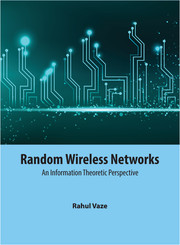Book contents
- Frontmatter
- Dedication
- Contents
- List of Figures
- Preface
- Acknowledgments
- Notation
- 1 Introduction
- 2 Transmission Capacity of ad hoc Networks
- 3 Multiple Antennas
- 4 Two-Way Networks
- 5 Performance Analysis of Cellular Networks
- 6 Delay Normalized Transmission Capacity
- 7 Percolation Theory
- 8 Percolation and Connectivity in Wireless Networks
- 9 Throughput Capacity
- Index
- References
4 - Two-Way Networks
Published online by Cambridge University Press: 05 May 2015
- Frontmatter
- Dedication
- Contents
- List of Figures
- Preface
- Acknowledgments
- Notation
- 1 Introduction
- 2 Transmission Capacity of ad hoc Networks
- 3 Multiple Antennas
- 4 Two-Way Networks
- 5 Performance Analysis of Cellular Networks
- 6 Delay Normalized Transmission Capacity
- 7 Percolation Theory
- 8 Percolation and Connectivity in Wireless Networks
- 9 Throughput Capacity
- Index
- References
Summary
Introduction
In this chapter, we consider a two-way transmission model for the wireless network, where all source–destination pairs want to exchange information in both directions over a single hop. This model is more realistic than the one-way single-hop model of Chapter 2, since most often in practice, the communication between nodes is two-way, for example, uplink/downlink in cellular networks, feedback for packet acknowledgments, control and channel state information.
For defining the transmission capacity with the two-way communication model, we define an outage event if there is outage in any one of the two directions. Since the outage events in the two directions in wireless networks are correlated, the transmission capacity analysis with the two-way model is non-trivial and does not follow easily from the one-way communication case. Thus, instead of deriving exact expressions for the transmission capacity as done for the one-way communication in Chapter 2, we resort to deriving tight upper and lower bounds on the transmission capacity for the two-way case, which only differ in constants. The tight bounds derived on the transmission capacity also allow us to find the optimal bandwidth/resource partitioning between the communication in two directions that maximizes the transmission capacity.
An added benefit of the two-way model of transmission model is that it allows us to quantify the loss in the multiple antenna transmission capacity with practical feedback in comparison to the genie-aided feedback. The multiple antenna transmission capacity analysis of the CSIT case in Chapter 3 assumes a genie-aided feedback, that is, the transmitter has error-free access to channel coefficients without accounting for resources used for feedback. In this chapter, we characterize the effect of practical channel feedback on the transmission capacity with CSIT and show that genieaided feedback is a severely simplifying assumption and there is significant performance loss while accounting for realistic feedback requirements.
- Type
- Chapter
- Information
- Random Wireless NetworksAn Information Theoretic Perspective, pp. 80 - 94Publisher: Cambridge University PressPrint publication year: 2015



